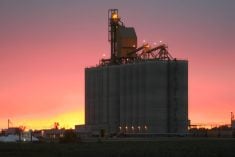I don’t get much chance to vaccinate cattle or do much else around the farm any more, so when I do I make a point of letting people know just so they don’t assume I am only a pretty face, who happens to be an incredible writer, too.
Yes, I am back at my desk after a grueling afternoon of vaccinating about 250 cows at my brother-in-law’s ranch in southeastern B.C. My sister-in-law Susie had the easy job where she administered the Tasvax 8 product, and my wife and I co-ordinated efforts for the much more difficult task of administering Scour Bos. Even on a +2 or +3 C day that stuff is like molasses. Took forever to fill syringes and then my thumb got tired from pushing the plunger. Life is hell, but we got the job done.
Read Also

Cancer agency reclassifies another herbicide ‘probably carcinogenic’
The WHO’s cancer research agency has now put atrazine, a herbicide well known to corn growers, in the same potential-hazard category where the agency put glyphosate.
My nephew and niece, Matt and Andrea, looked after running the chute and headlock as they lined up five at time in the chute. They also replaced the few dangle ear-tags that were missing, and trimmed ear hair so tags could be read. Brother-in-law Joe was in the back and kept the flow of cows coming into the corral. It all went smoothly really. Light breeze, but mostly a sunny, pleasant afternoon.
It stayed nice and dry where we were along the chute, but it got a bit sloppy in the back part of the corral as the day warmed and cows contributed more to any manure that was there. Sloppy manure on ice — you can’t beat that combination to make you rethink how fast you should run across a pen.
I have been on this gig a few times over the years, but it still surprises me how you can process 230 head without a fuss, but then you get down to the last 15 or 20 high-headed, dumb ones who use every ounce of their 1,300-pound body weight to avoid going down the alleyway toward the chute. They bunch up in a corner, and churn in circles like water going down a drain. And then there are one or two goofy ones who stop dancing around and decide to challenge you. Do you want to be brave or practical? How fast can an old guy run on sloppy manure-covered ice?
This bunch didn’t even respond to some very affirmative and unflattering language used by my brother-in-law. Finally, you get that one or two who are tired of turning in circles and they finally head for the alleyway and the rest follow. The ah-ha moment. Talk about slow learners.
But the cows got processed. They will be disease free. Their calves will have no scours. All humans are in good shape with nothing broken or bruised. The biggest problem now after a great lasagna dinner is trying to stay alert to the end of some TV show that ends at 8 p.m.
Lee Hart
Tracking Alberta lambs
Alberta’s lamb producers are answering the challenge to adapt their businesses to take advantage of growing demand for their product. Their numbers are up, which can be partly attributed to producers embracing technology that helps improve the management of their flock.
“Alberta’s lamb industry makes up more than 17 per cent of Canada’s total flock size,and that number is continuing to grow,” says Margaret Cook, executive director of the Alberta Lamb Producers (ALP). “We’re the only province in Canada that has seen a significant increase in flock size — we’re up 2.2 per cent in one year to a total flock of 183,000 animals. Part of that growth can be attributed to improved management practices and a willingness to lead the way in adopting advanced technology.”
Over the past several years Alberta producers have been introducing radio frequency identification technologies, or RFID tags and programs, to their operations as part of the traceability initiative in the industry. The RFID tags will provide enhanced animal identification and movement; the RFID technology provides advantages for flock management and opportunities for higher returns for producers.
The electronic tags and software provide a number of additional benefits for producers, including streamlining and making record-keeping more accurate, which can identify superior breeding stock, pinpoint poor performers and help producers become more efficient with their labour use. They offer feedlot owners opportunities to improve productivity; tracking processes, and offer smaller producers new and different ways to use feedlots.
Much of this information was gathered during the Alberta Lamb Traceability Pilot Project, a collaborative project with Alberta Agriculture and Rural Development funded by Alberta Livestock & Meat Agency. The project reviewed and field-tested RFID technology systems to see which hardware, software, and system components would work best together for the Alberta sheep industry. In addition to tracking how the tags could benefit on-farm management, the research project took the tag information into Alberta’s lamb supply chain to see how it could be used throughout the sector. Other provinces in Canada and countries around the world are now studying the project’s findings. †















